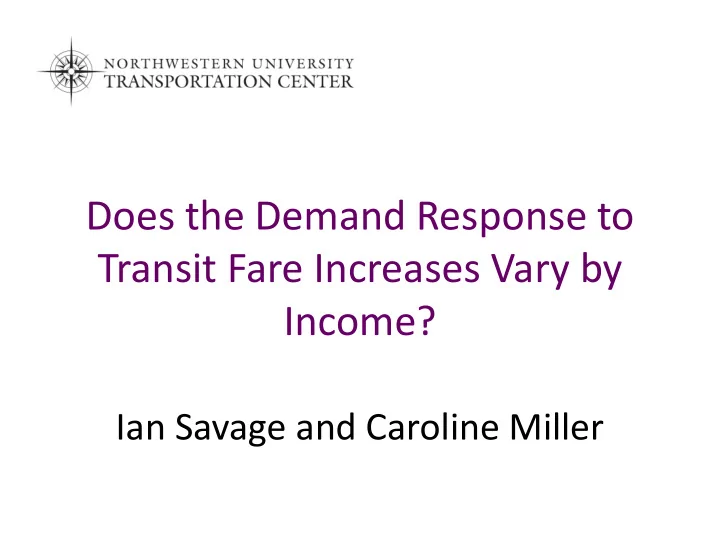

Does the Demand Response to Transit Fare Increases Vary by Income? Ian Savage and Caroline Miller
Why are we doing this? • Mobility for lower income groups one of the justifications for subsidy • Part of the political argument against fare increases, particular in flat-fare regimes • But are lower-income groups actually more fare responsive?
What we are going to do • Chicago Transit Authority (CTA) rail system • Look at change in boardings at non- downtown stations in the year after fare increases in 2004, 2006 and 2009 • See if ridership change varies in a systematic way with per-capita income in the neighborhood around the station
What we are going to do • Chicago Transit Authority (CTA) rail system • Look at change in boardings at non- downtown stations in the year after fare increases in 2004, 2006 and 2009 • See if ridership change varies in a systematic way with per-capita income in the neighborhood around the station
What we are going to do • Chicago Transit Authority (CTA) rail system • Look at change in boardings at non- downtown stations in the year after fare increases in 2004, 2006 and 2009 • See if ridership change varies in a systematic way with the per-capita income in the neighborhood around the station
Who are more fare sensitive? Riders in Riders in lower-income higher-income neighborhoods neighborhoods
Who are more fare sensitive? Tighter budget More travel constraint options Riders in Riders in lower-income higher-income neighborhoods neighborhoods
Who are more fare sensitive? Tighter budget More options constraint Riders in Riders in lower-income higher-income neighborhoods neighborhoods
Who are more fare sensitive? Tighter budget More options constraint Small prior literature reflects this ambivalence Riders in Riders in lower-income higher-income neighborhoods neighborhoods
• Looking at change in individual station entries in 12 months before and after a fare increase: – Jan-Dec 2004 versus Jan-Dec 2003 – Jan-Dec 2006 versus Jan-Dec 2005 – Apr-Dec 2009 versus Apr-Dec 2008 to allow for introduction of seniors ride free in March 2008
X X X Also excluded: Stations Brown Line Branch included - 2005-2006 on weekdays - 2008-2009 2003-4: 99 Fullerton to Belmont 2005-6: 86 - 2008-2009 2008-9: 95 Douglas Park Branch - 2003-2004 - 2005-2006 X
More than just fares changed Fares Employment Gas Prices Increased Changed Changed 2003-4 +12.3% +0.7% +17.4% 2005-6 +20.5% +3.2% +14.9% 2008-9 +11.8% -4.8% -27.7%
Fare ($) Demand Curve Station Entries
Fare ($) Demand Curve Station Entries
Fare ($) New Demand Curve Demand Curve Station Entries
Fare ($) Demand Curve Station Entries
Fare ($) Demand Curve New Demand Curve Station Entries
Neighborhood data • 2009 5-year (2005-9) American Community Survey • Year 2000 Census Tracts • Tracts that intersect half mile circle around each station • For stations less than 1 mile apart, define a “watershed” halfway between them
Neighborhood data • Income per Capita • Population density (persons per square mile) • Distance from downtown (N. Michigan Av. / E. Lake St) • Proportion of males • Proportion of ages 65+ • Proportion of children (0 – 14) Generally (and surprisingly) a low correlation between these variables
Neighborhood data • Income per Capita • Population density (persons per square mile) • Distance from downtown (N. Michigan Av. / E. Lake St) • Proportion of males • Proportion of ages 65+ • Proportion of children (0 – 14) Generally (and surprisingly) a low correlation between these variables
Weekday boardings 2003-04 20% 15% 10% 5% 0% -5% -10% -15% -20% $0 $10,000 $20,000 $30,000 $40,000 $50,000 $60,000 $70,000 $80,000 Income per Capita in Neighborhood Surrounding Station
Weekday boardings 2005-06 20% 15% 10% 5% 0% -5% -10% -15% -20% $0 $10,000 $20,000 $30,000 $40,000 $50,000 $60,000 $70,000 $80,000 Income per Capita in Neighborhood Surrounding Station
Weekday boardings 2008-09 20% 15% 10% 5% 0% -5% -10% -15% -20% $0 $10,000 $20,000 $30,000 $40,000 $50,000 $60,000 $70,000 $80,000 Income per Capita in Neighborhood Surrounding Station
Regression on change in boardings 2003-4 2005-6 2008-9 Income per capita +ve -ve +ve Popn Density +ve Distance from CBD -ve -ve -ve % males % 65+ % 0-14
The bottom line Weekday ridership change obtained from regression analysis holding population density, distance from downtown and proportions of males / seniors / kids at their mean values: Fares Employ- Gas Income per capita ment Prices 25 th 75 th percentile percentile ($14,000) ($42,000) 2003-4 +12.3% +0.7% +17.4% -3.5% -1.5% 2005-6 +20.5% +3.2% +14.9% +6.2% +3.7% 2008-9 +11.8% -4.8% -27.7% -4.1% -2.1%
The bottom line Weekday ridership change obtained from regression analysis holding population density, distance from downtown and proportions of males / seniors / kids at their mean values: Fares Employ- Gas Income per capita ment Prices 25 th 75 th percentile percentile ($14,000) ($42,000) 2003-4 +12.3% +0.7% +17.4% -3.5% -1.5% 2005-6 +20.5% +3.2% +14.9% +6.2% +3.7% 2008-9 +11.8% -4.8% -27.7% -4.1% -2.1%
The bottom line Weekday ridership change obtained from regression analysis holding population density, distance from downtown and proportions of males / seniors / kids at their mean values: Fares Employ- Gas Income per capita ment Prices 25 th 75 th percentile percentile ($14,000) ($42,000) 2003-4 +12.3% +0.7% +17.4% -3.5% -1.5% 2005-6 +20.5% +3.2% +14.9% +6.2% +3.7% 2008-9 +11.8% -4.8% -27.7% -4.1% -2.1%
Take aways • These results might support the ambivalence found in the prior literature • Some support that lower-income neighborhoods had a greater (negative) response to fare increases on weekdays • Of course, in a flat-fare system, continuing riders from lower-income groups suffer a greater budget hit
Contact Information . . . • ipsavage@northwestern.edu • (847) 491-8241 • http://faculty.wcas.northwestern.edu/~ipsavage/
Recommend
More recommend